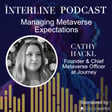Become a Creator today!Start creating today - Share your story with the world!
Start for free
00:00:00
00:00:01

Talking Innovative Polyester Textile Regeneration with Reju
Emma speaks to Patrik Frisk, CEO of Reju, a company working to recycle polyester at unprecedented speed and scale.
Together, they get into what it might take to secure fashion industry buy-in for industrial-scale textile-to-textile recycling - and what the future of the circular economy could look like.
Transcript
The Polyester Problem in Textile Recycling
00:00:07
Speaker
Polyester is the largest problem and and it's the largest problem because of a number of different things. One is the fact that it is the the the fiber that's the most dominant. 56% of all textile fibers are made out of polyester today.
00:00:22
Speaker
It's also one that is problematic because it does not degrade naturally in our environment. So we need to find a way to actually regenerate that fiber if we want to take care of it better. And today, so far, the technology has not been available to be able to do that at scale.
Introducing Reju and CEO Patrick Frisk
00:00:44
Speaker
Hello, everybody. Emma here, your host of the Interline Podcast.
00:00:49
Speaker
Today, I'm talking to Patrick Frisk, the CEO of Reju, a company working to recycle polyester at unprecedented speed and scale to keep up with the fashion industry's consumption of it. Owned by Technip Energies, an engineering and technology company, Reju's polyester is made from 100% textile waste that would be buried or burned with no bottle chips used, in theory making it completely traceable and helping to build a more open supply chain.
00:01:19
Speaker
Patrick has spent decades working for brands including Under Armour, The North Face, Timberland, and Vans. Even before the rise of fast fashion, he noticed that too many of these garments were ending up in landfills or incinerated. This drove him and his co-founders to use their expertise, their knowledge of the apparel industry, and their understanding of organizational frameworks to find new ways to use the materials clothing is made of when it reaches the end of its useful life.
00:01:48
Speaker
Riju's mission is applying this philosophy to polyester, which is one of the biggest sustainability challenges, as it remains the most widely used type of synthetic fiber in the world at a time when synthetic usage continues
Challenges in Industrial Textile Recycling
00:02:01
Speaker
to grow. In this episode, Patrick and I unpack the massive undertaking of recycling textiles on an industrial scale, what it will take to find traction and industry buy-in, why other institutions may have failed, and why Riju's modus operandi is different.
00:02:16
Speaker
And lastly, what the ideal longer term vision is for textile to textile recycling and the circular economy. Let's get started. Today on the Interline podcast, we have Mr. Patrick Frisk um of Riju. And it's such a pleasure to have him on here ah to speak about his career and his experience with the company. um And we're so excited to to have you on here, Patrick. So thanks for joining us.
00:02:46
Speaker
Thank you. Wonderful. So can we get started with you telling us a little bit about your career and what led you to be the CEO of Reju? Absolutely. So I've had the opportunity to work inside of the textile.
00:03:01
Speaker
and footwear and accessory business yeah for over 35 years. And in my last 20 or so, I've had the opportunity to lead some very fantastic global brands like the North Face, Timberland, Bands, Under Armour and others. I did start my career actually in this industry in the fabric business, working for W.L. Gordon Associates, the makers of Gore-Tex. So what is maybe a little bit unique about my career is the fact that I've actually worked across um the categories as well as you know initially with the fabric, which is not normally common. you You normally would tend to start in a category and then kind of end up there
00:03:51
Speaker
in your career, but I've i've had the opportunity to to do many things and and that has eventually led me here to read you today, which is now a new type of adventure for me in terms of my career, where I'm trying to help move the textile industry and into the next phase, which means that we need to think more thoughtfully about things that we extract from the planet and how we then integrate them into our in ah into our supply chain and ultimately also ah provide an opportunity to potentially regenerate them when when they find their end of life stage. Absolutely such an important cause and
00:04:37
Speaker
I guess if anybody is going to succeed in it, it is somebody like you with your your vast experience in all these different areas of your career. um I wanted to ask you next specifically about polyester textile waste. As you all know, it's one of the biggest sustainability challenges that we face in the fashion industry. um Something like over 60 million tons of polyester fibers are produced annually.
00:05:03
Speaker
and less than 1% of but global textile waste is recycled into new fibers for clothing. And that actually is a statistic from 2021. So I think it could even have become worse since
The Environmental Challenge of Polyester
00:05:17
Speaker
then. um not Not to be negative ah because you've chosen that to tackle actually. And can you give me some insight into why it is that you picked polyester despite the things, or should I say, ah considering the things I've just said, are there more reasons um and what level of scalability do you see as possible as well as the timeframe for that? ah Polyester is the largest problem and and it's the largest problem because of a number of different things. One is the fact that it is the the the fiber that's the most dominant. 56% of all ah textile fibers are made out of polyester today.
00:05:59
Speaker
It's also one that is problematic because it does not degrade naturally in our environment. So um we need to find a way to actually regenerate that fiber if we want to take care of it better. And today, ah so far, the technology has not been available to be able to do that at scale ah in an economic way. So there are certainly ways that you can break down polyester, many different ways you can break down polyester,
00:06:27
Speaker
But the trick is to make sure that you can do it at scale and you can also also do it economically. But that's not enough. You also need to make sure that you can separate the polyester from other things. And that's particularly difficult in textiles. you know We use tens of thousands of different chemicals and textiles. And when I say textiles, we we tend to, I guess, automatically go to to things that we know well, like apparel. then But the reality is, you know, polyester fibers exist in everything from carpets to airline interiors, core interiors, bedding, for example, most mattress covers in the world are polyester, 100% polyester. and So it isn't just in the most obvious things like garments, it's across everything.
00:07:16
Speaker
um and therefore also such an urgent problem for us because if it isn't naturally degrading and if we're not able to yet ah do it at scale, what that means is that you either have to dig it into the ground or burn it when when it's ah found its end of life.
00:07:39
Speaker
and And that is of course a big problem for us because um the amount that we today either incinerate or or um put into landfill is over 85% of all textiles. So if if that's going to continue, not only are you extracting a finite um ah product, which is oil, right, to make polyester,
00:08:06
Speaker
you're also creating a a massive waste problem on the other side that is going to be one of the things that I think is is is
Urgency for Regenerative Solutions
00:08:15
Speaker
really going to make people wake up is is the fact that there's just so much waste. So we have a societal problem in front of us in terms of what to do with all this waste because we continue to consume more and more and more textile every year. We've doubled the consumption essentially in terms of apparel from 2000 till today.
00:08:34
Speaker
and And the predictions right now is that it looks like we're going to pretty much double again by 2040. And that's only 16 years away. So it's an urgent problem. um But the problem so far has been our inability to actually do regeneration at scale, specifically with polyester. Yes, absolutely. And I think a lot of people, including myself,
00:08:58
Speaker
forget sometimes that it's not just clothes. It is things that you mentioned. bedhe sits It's It's a whole range of things that are easy to forget about. And ah so going back to to what I asked, um what is the timeframe actually for solving this crisis? um And how is it possible to achieve scalability? Obviously, that's what you're working on. um yeah Do you think we're going to be able to make a difference by 2040? Or is it longer than that?
New Infrastructure Needs for Textile Waste
00:09:29
Speaker
Well, we have to get started. And I think yeah to to really illustrate why there is should be a sense of urgency, the textile industry has basically gotten a free ride on infrastructure that has been built for other things. And what I what what i mean by that is, today, you know we extract oil. we We put that oil into a pipeline and that that creates many different types of products. um so So the infrastructure to create polyester basically goes through this infrastructure that's existed now for over half a century or so.
00:10:05
Speaker
um and And it's a very efficient, highly inexpensive because of the ability to to leverage that infrastructure. And it's fast, it's relatively fast. and We've also built these very large polyester factories to take care of this, ah you know, product that's that's coming flowing through the pipe, so to speak, um in a very efficient manner. Now, if you're if you're going to,
00:10:32
Speaker
do something different, which is to take waste and now turn that waste into raw material instead of using oil, you actually have to then of course put it through a different system, a different infrastructure.
00:10:45
Speaker
ah build, if you like. And the problem we have as a society today is the fact that it does not exist. We do not aggregate textile waste separately at scale anywhere in the world. ah We do not sort it for fiber. We sort it for wearability, in other words, for reuse and resell, which is great. And it's you know very, very needed, of course.
00:11:10
Speaker
But to actually sort it for fiber, you need to actually build very large facilities that actually doesn't look at the style so much as looks at what is the composition of of this garment, carpet, bedding, whatever it might be, and and so that we can then sort it into the right piles for regeneration.
00:11:32
Speaker
um And then ultimately, you need to also be building a regeneration center. In other words, a place where you take this textile once it's been both sorted for fiber and where you removed all of the disruptors, things like zippers and buttons and what have you, into the raw textile.
00:11:51
Speaker
And then you can start the regeneration process. You need to build these factories to be able to do that, or or as we call them regeneration hubs. And they are very large and very, very costly. So it is it's ah it's a quest to really build this infrastructure that needs to begin. um And you need to to do that over a period of time. So to answer your question, will we be there in 2040?
00:12:15
Speaker
Well, and I can tell you it's going to take time. So and this is a generational thing in terms of how to think about this. So we have to get going with it because what you started by talking about the amount of polyester that's made every year. That's every year. To build a new infrastructure system, we're talking about decades.
00:12:36
Speaker
So to to tell you that we will be having solved this problem by 2040, I think would be incredibly optimistic. but But I do believe that we have to have a sense of urgency to get going with it because we don't. um it It will be a waste crisis beyond what I think anybody realizes today very, very shortly.
00:13:00
Speaker
Yeah, absolutely. not to Not to make anyone panic, but it's true. It's absolutely true. um And I want to talk a little bit about technology now. um During your time at Under Armour, you were inspired by the technology, which IBM pioneered, that could separate polyester fibers from other clothing ah materials and experiments.
00:13:23
Speaker
Uh, the sounds easy, but I think it's actually not really as easy as it sounds. Um, and before you and I have also spoken about your work with technip energies and they had a vision on how to sort of scale this technology. So now, uh, Reju is working with technip, um, who uses Volcat, which is, um, that IBM technology produced.
00:13:48
Speaker
with Under Armour. And can you tell me a little bit more about how bigger role technology has played, I guess, in the idea and the vision of Reju? And do you think it's necessary to have a tech camp company actually backing every fashion startup today with big ambitions to do something in the recycling space or elsewhere?
Technological Innovations in Polyester Recycling
00:14:11
Speaker
Yeah, it's it' ah ah it's a fantastic question because I think we we began a little bit here talking about the infrastructure and and the things that need to be built to facilitate this new ah system ah that is composed of an ecosystem of players right that need to work together too to facilitate the system. and ah When we started looking at this at Under Armour, we had a very big target ahead of us in terms of how we thought about using recycled material. But as as I learned more and as the team learned more, we also realized that the source that was being used, which was predominantly bottles and still is predominantly bottles in terms of the regenerated
00:14:54
Speaker
ah polyester that does exist out there today and there's quite vast amounts of of recycled polyester that is that is used from bottles. We realized that that probably was not sustainable because ultimately the bottle industry needs to have their their recycled bottle ah material back to to use it for new bottles themselves. And we saw that you know we were going to be a growth company. We would would need more and more of this. And we would need to wane ourselves off the virgin to get more recycled. But preferably, we'd like to do it with textile, because ultimately, that was what we were producing.
00:15:35
Speaker
And and we we were looking across the world for technology. We found this technology with IBM that was in its early phases. They at that point in time were looking more at the bottling industry. We made them perhaps a little bit more aware that there was an opportunity with textiles. And Technip also got involved and and the three of us together um began a journey to try to understand whether textiles was actually an opportunity for this technology.
00:16:05
Speaker
Fast forward to 2023, where we together created a company ah called Reju that's 100% owned by Technip Energy. So Technip decided to to really pull ahead and and explore how this technology could be commercialized, which is the process that we're in right now.
00:16:26
Speaker
And the reason we did that was because we believe that this technology has the ability to do what is so hard, which is separate the polyester out from the textile and to be able to do that at scale. So we are not focusing on bottles or packaging or or or any of the things that many other but companies are are trying to to solve for. We're focused on the most difficult, which is textile. And we're doing that because we believe our technology can can do it at scale. ah But but too to to build it out a little bit more and answer your question,
00:17:04
Speaker
um It isn't just possible to be successful by just having a technology. um And the reason for that is and because you have to actually make sure that you turn what is today you know textile into a new raw material.
00:17:22
Speaker
at scale ah so that you can build factories at scale. Because what you're competing against, right remember, is Virgin ah Polyester, predominantly, which is now today refined in a very sophisticated, efficient, tried, trued, and tested pipeline, if you like, of of infrastructure. So you need the technology, but you also need the ability to help ah participate and build this infrastructure. and Therefore, being owned by a very large and and incredibly competent engineering company helps us not just do what we need to do to build our own ah regeneration hubs or or or or factories, ah but it also helps
00:18:11
Speaker
our partners because we understand some of the stuff that they will need to go to to build out, for example, sorting um facilities or or or how to think about logistics and aggregation of waste and all of the other things that are so critical to make this actually a system.
00:18:30
Speaker
And I think that is that is why ah nobody has been able to necessarily do it before is because it is complex. It involves many different partners. It's an ecosystem. And therefore, and having the not just the technology, but having the capability to build out the technology and to continue to engineer the actual ah process. So at TechNet, we have not only building engineers, we also have chemical engineers, and Technipis is a very unique company in that sense. We have ah a polymer division at Technip called Tansimmer, and we we today have built an enormous amount of polyester plants through the last 70 years that that the Tansimmer group has been town simmer has been active, and therefore know a lot about polyester in itself. so
00:19:25
Speaker
being able to regenerate polyester through Reju and then work with Tan Simmer, our parent company, Technipenergies, one of the divisions, to actually make polyester ah better is the other endeavor that we're doing. So for us, it is so helpful to to to be owned by somebody that that's an engineering company because of that reason. You need, not just the technology, you need the technical expertise to build it out. And in our case with ReadU, we also have the textile experts
00:19:59
Speaker
to help downstream when we start to talk about integrating this into the brands as well. So people like myself, having worked you know a lifetime in in the industry, we have many others in our in our organization that are also experts in yarn and fabrics and what have you, because once we've done our job of regeneration,
00:20:21
Speaker
and we have the polyester back in its pure form. We need to also then integrate it into the supply chain of of the brand so that they can make new things. And that's also something we believe we can ah help improve. ah you know There's an opportunity for us to actually make recycle, not necessarily a a something that feels like something not premium or not and as good. We believe and you know regeneration is all about rejuvenation. So in other words,
00:20:52
Speaker
Because we have this ah expertise, we also know that we can build better yarns and better fabrics that shed less microplastics, use less bad chemicals, and actually are able to contribute to a ah better sustainability journey in their second life. So why not make the second life better than the first if we can?
00:21:13
Speaker
Yeah, absolutely. What a complicated process though. it's ah iwellia Thank you for taking on taking on that role because I ah do think that it's something that everybody has to buy into um and it's really not something
Expanding Reju's Recycling Capabilities
00:21:29
Speaker
simple. and Having the expertise that you've just mentioned now is is going to be critical. um and just We spoke a bit about factories now. I know last year, Reju opened ah its ah research center in Frankfurt. You can just confirm that that's correct. um do How many factories do you have online or facilities, should I say, are online at the moment? Yep, that's absolutely correct. We we opened our our um R and&D center in in Frankfurt. And the reason we did it in Frankfurt is because, well, first of all, it's in the middle of Europe, which is convenient. Second thing is that that's where we also have our
00:22:10
Speaker
10 Simmer chemical engineers sit so we can collaborate and cooperate with them on a daily basis. And the third reason was that we intended to build our first regeneration hub ah in Frankfurt, ah which we've now done. So interesting fact, we began building it in September last year and we finished building it in July this year in 2024. So that's and I would think a record in this industry in terms of going from nothing to a functioning um ah regeneration hub in in in about 10 months time. That's where we will now start to um do the work in earnest and that is of course
00:23:01
Speaker
also very exciting because we know that we will now be able to buy early next year, um actually deliver product from this this hub. ah And on the back of that, we are now planning to build two new ah facilities at scale, large scale, one in North America and one in Europe um in the not too distant future. And when I say that,
00:23:27
Speaker
ah The plan right now is to have them operational by 27 or 28. And some of that will depend a little bit on the development work that we'll be doing in Frankfurt. but um That is now something that of course we're excited about. I think the industry should be excited about because we now are getting to the first early phase here of of making sure that what has been so far done at
00:23:59
Speaker
lab scale is now going to of course go into more of a commercial size unit. It's always this way when you when you do these kind of technologies that you go through different phases. and What's unique about what we've done is that we've been able to do it so quickly. And that that should give us pause and also optimism for what could be in the future as we continue this development down the line.
00:24:28
Speaker
Yeah, definitely. And you just mentioned the industry. um What we've seen is that sometimes despite the advancements being made and the demand actually that there is for textile recycling, there's still some resistance or some problems with traction to actually have the buy-in that's necessary to take it to the next step.
Brand Buy-In and Integration Challenges
00:24:52
Speaker
um What do you think Riju is going to do differently um to try and get what you're doing to an industrialized scale where brands and and really everybody is buying into this initiative where in the past things haven't worked.
00:25:10
Speaker
Well, I think first of all, we're taking a holistic approach. so So I mentioned a little bit some of the capabilities that we have. Well, we we we are able to with the um capabilities and the expertise that we have inside of our company to work across the entire ecosystem. And it really is important to understand that even if you have the best technology in the world, that does not necessarily mean you're going to be successful. You actually have to work across ah the entire feedstock cycle if you like or or or the aspect of understanding how you will ah reverse logistically ensure that you're going to have feedstock, the right kind of feedstock for for your your regeneration.
00:25:58
Speaker
You also have to understand deeply downstream how brands actually operate. In other words, every brand, depending on whether it's in luxury or sporting goods, outdoor um sports, where it doesn't really matter, and you need to understand that most most likely all of them have somewhat of a different go to market in terms of their timelines, and their manufacturing profile, where they make the stuff, what they make, how they make it, et cetera.
00:26:27
Speaker
It's incredibly important to understand all of that so that when you actually do ask them to take what they have today and replace it with something new, it has to be a seamless and effort, so to speak. right You have to really understand how to work with their timelines, their go to market to ensure that you're not being disruptive. That's one big hurdle.
00:26:49
Speaker
of course um I think the other hurdle for for brands is ah what what they see coming. and And we all know that there will be regulation in many different ways for the industry and going forward. it it It will have to be.
00:27:06
Speaker
um and If you look at it in the European context, of course, um the European, especially through the Eurotex initiative and other things are working very hard to make sure that that the industry will adjust over time. so So from a brand perspective, it's balancing what you do today with yeah starting your transformation or your transition into what the regulation will be in the future. um We all need to understand how will we pay for all of this.
00:27:39
Speaker
As I said when we started discussing our discussion here today, ah we're going from a system that is today half a century old. you know It's a refined system and that works, ah highly efficient. We need to build a new system that's going to cost money and and and therefore we need to be able to pay for it. now Some of the regulation is or should help with that things like EPR and producer responsibility Taxation if you like that is coming in is actually meant to be used to pay for some of this infrastructure build But not all of it will so certainly there will be a premium to to pay to work through this transition the good news is much less than most people think and and why is that well because
00:28:28
Speaker
First of all, and the most the the most important thing is, you're not going to replace everything at once. Building these very large regeneration hubs of 50, 60, 70 kilotons takes time.
00:28:44
Speaker
you know It takes about three years to build a factory, whether you have some strong partner like Technip in your back or not, simply because it'll take a year to do the um permitting and about two years to build these large factories. And they cost a lot of money. you know ah To build a large factory like that could cost anything from $150 to $300 million, dollars depending on size and scale and and location and what have you.
00:29:10
Speaker
That needs to be funded. And there's there's no funding that's going to take place unless the people that will fund it understand whether there's an offtake for for the for the investment. and But I think the the good news, as I said, is that and it will take time right to to replace all of that.
00:29:30
Speaker
quantity that that every brand needs to ultimately replace. So there's an opportunity for us as an industry to work together to make sure that we mitigate the effect it might have. And one of the reasons we are excited about this is because we feel that we can actually make a better product.
00:29:51
Speaker
So if you take into consideration that you have a time aspect to this and the fact that we believe we can make better yarns, better fabrics that actually perform better for the end consumer and are more sustainable, ah doing those two things together, ah i I believe will will bring a more premium product also to market, which I think will help the brands to some extent ah in terms of how they think about their pricing policy for sure, but also looking at other efficiencies, ah things like nearshoring that could also help you know offset things like transportation costs, looking at quicker turn, you know other things in the actual um and entirety of the of the of the system that we're talking about. so
00:30:41
Speaker
It again, coming back to the same thing, it isn't just one thing, right? It's many things. What I am excited about having lived a life inside of this industry is that I believe it can be done. and I'm very optimistic about it um if you're willing to do the work.
00:30:59
Speaker
And I think I don't see anything that if I were a CEO today of a large apparel brand again, that I would not take on because the actual impact to my own ah financials is actually so small.
Regulations and Financial Implications for Brands
00:31:16
Speaker
ah but But if I think about it over time, what it could do to help out, both in terms of derisking my own supply chain and my own future as a brand, but also to be a growth enabler. Because if I'm not going to be able to get access to this kind of product in the future, how will I be able to grow with regulation and other hindrances that are being ah potentially or obstacles that might come in my way? so I am optimistic, I believe it can, it can be done, but it will take, it will take, yeah like the old saying, it will take a village to get it done for sure. And and and ah we here at Riju have on purpose staffed ourselves with some of the best people in the business to make sure that we can work across the ecosystem to be the facilitator and the connector to also help this work get going.
00:32:09
Speaker
Yes, for sure. I'm really happy to hear that you're optimistic because I think sometimes the more you know, the more you research, the more you think about each step and each stakeholder and and player that has to buy in and and do all these things that you've mentioned, it's sometimes easy to to be overwhelmed and think just, you know, how is this going to happen? But I think what you've really touched on is it's going to take time, but it's time to start for everyone. and You have to look at the the longer term picture. I mean, it's happening in the short term in terms of the legislation. Like there are a few things already coming into play in January, 2025, which is now less than six months away. So it's, it's not a far away sort of, um, uh, like imperative that the brands and and retailers and everybody has to look at the legislation will take some time, but actually.
00:33:05
Speaker
we have to start looking at the longer term picture and acting now. And you've touched on this throughout our conversation now, but. What do you think is Reju's vision and what is your vision for the future?
Reju's Vision for a Sustainable Future
00:33:20
Speaker
Does Reju have a plan to be part of the secondary market? We've spoken big picture, but um is there something else you'd like to say about textile to textile recycling and the circular economy in general? um Basically, where where do you see Reju in the next five to 10 years? ah Where is it going and and how can we
00:33:43
Speaker
as an industry support the vision? Well, but first of all, we have a vision, you know, Regis Vision is a world designed to last and I think that's pretty pretty fitting in terms of what we're undertaking. we We're also a purpose driven company um and we believe that our purpose is unlocking infinite possibilities within finite materials and And you know to do that, um there's ah there's a time, there's a scale and that that strategy comes with for sure. um And you know the only ask we really have from the industry is is, let's work together on a big project. Because I think the industry ah has had a tendency, and this is just an observation for myself having been part of the industry for so long,
00:34:31
Speaker
to to piecemeal things. um And it's not for lack of trying. There's actually an enormous amount of enthusiasm for, let's say, sustainability in general out there. I think the industry realizes where we're at. And we want to do things to move things forward. But the reality is now we need a big effort on a big project.
00:34:55
Speaker
um So why not take on the most difficult of them all, right? Take on the biggest problem that will have the most impact. And to be able to do that, we need to also come clean with an understanding of where the problem is. Today, you have to problems that are that are driving this and also a very big benefit if we do it together. The two problems are the fact that we're using finite materials to create infinite waste. That's not a good model going forward.
00:35:28
Speaker
ah We can now, through new technology, use less carbon. And as a side note, our process uses about 50% less carbon emissions than if you use virgin. And I'm now talking about end to end. So this is not just our process. This is if you go from current infrastructure, taking oil out of the ground to polyester or taking it from waste aggregation,
00:35:52
Speaker
to polyester and were 50% more efficient in terms of the carbon emission. So to do this job um holistically, we need to come together as an industry and we need to actually face ah face this together. And we should not be afraid to do so because this will take time.
00:36:14
Speaker
So whether you have to adjust your supply chains, whether you have to pay a little more, ah whether you have to make an effort, you will have to do that over time. So this is something you can actually plan into. And and that's how I would think about it if I were a CEO. I would say, OK, how do I buy myself a bit of insurance here?
00:36:35
Speaker
How do I make sure that I at least get going with this and I start? And this looks great because I can do it step by step. I can start by walking before I run. I can start by crawling maybe even before I walk.
00:36:49
Speaker
and And that is really the approach the industry streets should take. ah and And what I'm hoping we're going to be able to achieve with Riju is that ah pull the industry together, change the world together, and we're able to do that now with the technology that would unlock that ability. Now again, the technology by itself isn't going to help anybody.
00:37:12
Speaker
It is just the unlock. We have to create and build this entire infrastructure platform, if you like, and system that now begins with the new raw material, which is textile. We have to work downstream to make better yarns, better fabrics, so that we pollute less in its second life and actually make it more durable, and also so that we can ensure that the consumer actually gets a benefit from this from a performance perspective.
00:37:39
Speaker
Well, how would they get that? Well, they will get it because we'll make yarns and fabrics that will shed less, that will be more comfortable, that will be and more durable so you can use them longer and preferably give them to someone else once you're done so that they can reuse it and re-wear it.
00:37:59
Speaker
That's what we need to do as an industry. And I think, read you, with the with the vision that we have of a world designed to last, with the experience, ah capacity, capability, and financial ah horsepower that we have, we'll be able to at least initiate this. So I'm hoping five years down the road, 10 years down the road, that we've been able to build regeneration hubs that are called hubs for a reason. They're not factories, they're not plants, because we're also intending to use these places for education, for places where the industry can come together, where we can demystify ah regeneration and make it something that people believe in, right? ah as As one of the ways that we can make this world perhaps just a little bit better going forward.
Conclusion and Call to Action
00:38:47
Speaker
Absolutely. Patrick, it has been an absolute pleasure hearing your insights on this and your positivity is really infectious, um leaving this on a really great note. So thank you very much for having um having been on the podcast today and hopefully we get to see some more from ReadU very soon. We'll be watching your journey closely. My pleasure. Thank you very much. I hope you enjoyed my conversation with Patrick.
00:39:14
Speaker
Be sure to give Rijo a follow on their social media platforms as they grow and stay ahead of some of the exciting announcements they have coming in the new year. To make sure you don't miss an episode of the show, subscribe to the Interline Podcast wherever you listen to podcasts and give us a follow on LinkedIn and Instagram. You'll also find much more about textile recycling, circularity and sustainability in our newly released 2024 Sustainability Report. The report is completely ungated and free to read.
00:39:43
Speaker
and is essential reading for all fashion professionals wanting to understand, develop and roll the technology solutions are playing in changing the sustainability profile of fashion and how far the industry still has to travel. Lastly, make sure you subscribe to our weekly newsletter, where we give you our analysis on the biggest stories of the week in the world of fashion technology. I work on those breakdowns with the rest of the team here at the Interline, and we put a lot of thought each week into not only capturing the top headlines, but really analyzing them.
00:40:14
Speaker
You can access that newsletter on our website by clicking the newsletter icon in the top right corner of the screen, and it will be delivered straight to your inbox every Friday. Thanks for listening. See you next time.


















